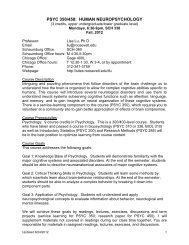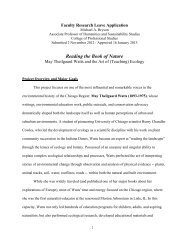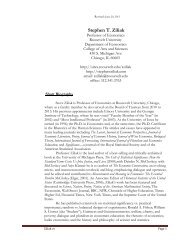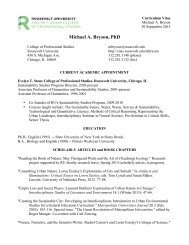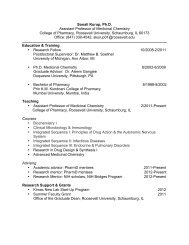Social Insurance and Public Assistance
public-assistance-welfare-reform-colonial-times-to-the-present-ziliak ...
public-assistance-welfare-reform-colonial-times-to-the-present-ziliak ...
Create successful ePaper yourself
Turn your PDF publications into a flip-book with our unique Google optimized e-Paper software.
SOCIAL WELFARE PROGRAMS Series Bf746–761 817<br />
Retirement <strong>and</strong> survivor<br />
monthly benefits awarded Monthly benefits in current payment status Benefit payments<br />
Lump-sum Retirement Total lump-<br />
Railroad death benefits annuities <strong>and</strong> Spouse Total survivor sum survivor<br />
employees Recipients Total Retirees Spouse Survivors Total Retirees Spouse Survivors awarded Total pensions annuities annuities payments<br />
Bf746 Bf747 Bf748 Bf749 Bf750 Bf751 Bf752 Bf753 Bf754 Bf755 Bf756 Bf757 Bf758 Bf759 Bf760 Bf761<br />
Fiscal year Thous<strong>and</strong> Thous<strong>and</strong> Number Number Number Number Number Number Number Number Number Million dollars Million dollars Million dollars Million dollars Million dollars<br />
1980 532 — 83,476 40,511 22,268 20,697 1,203,006 639,314 233,916 329,776 — 4,730.6 2,754.9 634.9 1,327.2 15.6<br />
1981 503 — 82,854 41,176 21,346 20,321 1,202,364 641,787 233,977 326,427 — 5,286.6 3,070.7 709.1 1,492.8 13.6<br />
1982 440 — 84,395 39,985 21,613 22,787 1,200,427 642,640 234,009 323,621 — 5,725.6 3,342.1 755.9 1,617.0 13.8<br />
1983 395 — 81,260 38,687 20,231 22,323 1,193,226 640,985 232,367 319,730 — 6,041.1 3,548.7 805.5 1,676.1 10.6<br />
1984 395 — 72,237 33,176 18,587 20,461 1,182,606 635,821 230,433 316,218 — 6,099.9 3,602.6 815.2 1,670.8 10.8<br />
1985 372 — 68,334 31,316 18,286 18,720 1,165,202 626,521 227,284 311,274 — 6,251.0 3,699.8 839.6 1,702.4 11.3<br />
1986 342 — 69,330 31,875 17,850 19,590 1,151,861 619,548 224,642 307,551 — 6,329.5 3,760.6 847.4 1,711.9 9.3<br />
1987 320 — 68,224 32,903 18,040 17,271 1,139,782 614,024 222,303 303,342 — 6,520.3 3,897.4 876.2 1,737.0 9.5<br />
1988 312 — 67,057 32,297 17,776 16,973 1,124,645 607,088 220,093 297,264 — 6,675.9 4,017.6 897.4 1,752.9 9.7<br />
1989 308 — 66,572 30,403 19,583 16,577 1,111,630 600,065 220,483 290,977 — 6,938.6 4,198.0 942.9 1,789.5 7.9<br />
1990 296 — 60,743 27,689 17,036 16,006 1,094,112 590,660 218,475 284,878 — 7,194.6 4,376.5 980.4 1,829.6 8.1<br />
1991 285 — 55,181 24,434 15,641 15,096 1,074,199 579,377 215,733 278,993 — 7,490.8 4,573.5 1,019.7 1,890.9 8.0<br />
1992 276 — 52,298 23,277 14,442 14,566 1,050,546 566,804 212,036 271,619 — 7,693.9 4,705.1 1,048.8 1,933.1 6.7<br />
1993 271 — 49,014 20,691 12,719 15,597 1,024,439 552,339 206,967 265,050 — 7,872.3 4,825.7 1,070.4 1,969.1 6.8<br />
1994 266 — 44,378 19,205 11,847 13,315 998,280 536,856 201,327 258,014 — 7,978.9 4,890.7 1,088.3 1,993.6 7.2<br />
1995 265 — 42,072 17,771 10,407 13,886 967,175 521,400 195,082 250,611 — 8,059.2 4,963.1 1,079.7 2,009.5 6.3<br />
1996 257 — 38,635 16,707 9,576 12,343 936,428 505,483 188,281 242,581 — 8,113.6 5,013.3 1,075.9 2,018.5 6.8<br />
1997 253 — 38,293 16,788 9,175 12,323 906,741 490,448 181,399 234,816 — 8,205.7 5,091.0 1,075.3 2,033.8 5.9<br />
(Z) Series Bf751 <strong>and</strong> Bf755, fewer than 500 benefits. Series Bf760–761, less than $500,000.<br />
Sources<br />
The Railroad Retirement Board Statistical Supplement to 1980 Annual Report,Tables B-1, B-2, B-3; The Railroad<br />
Retirement Board: Statistical Tables Through FY 1990,Tables B-1, B-2, B-3; The Railroad Retirement Board: Statistical<br />
Tables Through FY 1998,Tables B-1, B-2, B-3, D-1 (available from the Internet site of the Railroad<br />
Retirement Board).<br />
Documentation<br />
The Railroad Retirement <strong>and</strong> Carriers’ Taxing Act of 1937 established the railroad retirement system<br />
forrailroad employees as a program separate from the <strong>Social</strong> Security system. The 1937 Act provided<br />
annuities to retired employees based on their earnings <strong>and</strong> service. The system was to be administered<br />
by the U.S. Railroad Retirement Board. Annuities were paid at age 65 or later regardless of length of<br />
service, although persons between the ages of 60 <strong>and</strong> 64 could receive benefits (at reduced levels)<br />
after thirty years of service. Disabled workers could receive a full annuity for disability only if they<br />
were totally <strong>and</strong> permanently disabled <strong>and</strong> had thirty years of service. Persons between the ages of<br />
60 <strong>and</strong> 64 could receive a reduced annuity after less than thirty years of service. Under the 1937 Act,<br />
survivor benefits were limited to a lump sum of 4 percent of the employee’s creditable earnings, less any<br />
previously made annuity payments. The system was financed by taxes on employers <strong>and</strong> employees.<br />
Initially, employers <strong>and</strong> employees each contributed 2.75 percent of an employee’s earnings up to $300<br />
monthly.<br />
Amendments in 1946 lessened the restrictions on disability payments <strong>and</strong> divided jurisdiction for<br />
survivor’s benefits between the Railroad Retirement Board <strong>and</strong> the <strong>Social</strong> Security Administration. In<br />
1951, further amendments added annuities for the spouses of retired railroad employees <strong>and</strong> made<br />
provisions for <strong>Social</strong> Security to assume the jurisdiction of benefits for employees with less than ten<br />
years of railroad service. The intention of the latter amendments was to ensure that Railroad Retirement<br />
benefits would be no less than the benefits that would be given under <strong>Social</strong> Security for similar<br />
service. In 1965, the Railroad Retirement tax base was coordinated with that of <strong>Social</strong> Security, <strong>and</strong><br />
Medicare benefits were extended to railroad retirees <strong>and</strong> their families.<br />
The Railroad Retirement Act of 1974 restructured the original act into a two-tier system of benefits<br />
in order to eliminate duplications in Railroad Retirement <strong>and</strong> <strong>Social</strong> Security benefits. The first<br />
tier takes into account both Railroad Retirement <strong>and</strong> nonrailroad <strong>Social</strong> Security credits <strong>and</strong> provides<br />
benefits equal to <strong>Social</strong> Security benefits. The second tier focuses on railroad service exclusively <strong>and</strong><br />
provides benefits comparable to those in other industries with pension systems that provide benefits<br />
over <strong>and</strong> above <strong>Social</strong> Security. Subsequent amendments in the 1980s <strong>and</strong> 1990s changed some eligibility<br />
requirements as well as employer <strong>and</strong> employee tax contributions.<br />
For a complete, detailed history of the Railroad Retirement System, see the U.S. Railroad Retirement<br />
Board’s Railroad Retirement H<strong>and</strong>book, available at its Internet site.<br />
Series Bf746. Represents the mid-monthly calendar year average of the number of railroad employees.<br />
Series Bf748. Includes annuities to parents from 1981 forward.<br />
Series Bf757. Includes a small amount of payments for Hospital <strong>Insurance</strong> benefits for services in<br />
Canada.<br />
Series Bf755. Includes annuities temporarily being paid at spouse annuity rates, pending final adjudication<br />
of survivor annuities.<br />
Series Bf759. Beginning in 1982, includes divorced spouse annuities. Further disaggregated information<br />
is available from the Railroad Retirement Board.<br />
Series Bf760. Includes survivor (option) <strong>and</strong> parents’ annuities.



